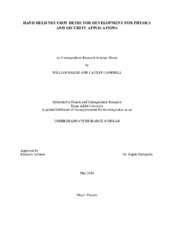| dc.description.abstract | The Cryogenic Dark Matter Search (CDMS) uses silicon and germanium detectors in the search for Weakly Interacting Massive Particles (WIMP), a candidate for dark matter. Although these detectors are heavily protected with lead and polyethylene, high energy neutrons may penetrate through the shielding and cause nuclear recoils on the detector that may be mistaken for a WIMP interaction event. The purpose of this project was to create a detector that shields as well as tags incoming neutrons to measure the background neutron noise. We present two designs using the high thermal neutron cross sections of boron and gadolinium inside a polyethylene casing. The incoming fast neutrons are produced from the interactions of cosmic radiation with rock. These fast neutrons are slowed to thermal using hydrogenous material such as polyethylene where the thermal neutrons are easily captured by either a gadolinium or boron source. Both boron and gadolinium release ionizing radiation in the form of alpha and gammas upon neutron capture. A boron nitride ceramic was chosen for its high boron density, and the reaction products of alpha particles are detected with a commercially available Ortec alpha detector. Alphas readily interact with matter and are easily blocked with even a very thin material. Because of this, the boron nitride must be positioned directly adjacent to the detector interface, leading to a compact design about 5 inches in diameter and 6 inches in length. To detect the gammas released by gadolinium neutron capture we employ a plastic scintillator that converts the ionizing radiation into visible light. Bicron 408 converts gammas into visible light with a wavelength of maximum emission at 430nm, which is readout by an avalanche photodiode. Because outside gammas and gammas decay products are indistinguishable in this project, the efficiency of neutron detection will not be determined until the system is tested inside a lead casing in which outside gammas will be shielded. In both regimes, signals will be produced through conventional means and calibration with known sources (Cf¬242) will allow for approximate energies to be recorded. | en |


